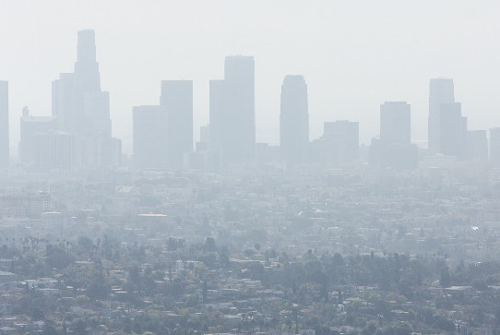Extreme weather event intensification: hurricanes
Are extreme weather events becoming more common and more destructive? An analysis of hurricanes may provide valuable insights.
For the past two decades, hurricanes have been growing in frequency, intensity, and impact. One of the strongest in recorded history was Hurricane Otis, which made landfall in late October 2023 near Acapulco, a major tourist destination on Mexico’s Pacific coast. In less than 24 hours, Otis intensified with unprecedented rapidity, growing from a tropical storm to a Category 5 hurricane. It claimed more than 40 lives and caused property damage that current estimates say could climb as high as $15 billion ($6.5 billion for the insurance industry).13
Climate scientists see rapid hurricane intensification as a consequence of climate change. One factor has been global ocean water temperatures, which have been rising due to the absorption of heat generated by increased atmospheric CO2 levels. CO2 concentrations are now 50% higher than in the preindustrial era, which has increased ocean water temperatures and consequently provided more energy for storms to form and intensify.
Until recently, hurricane damage could be mitigated to a certain extent as hurricanes intensified gradually, allowing for timely advance planning, public advisory issuance, and resource allocation. Climate change is now making it harder to predict hurricane behavior, and therefore more difficult to implement advanced mitigation plans.
Extreme weather events: direct and indirect mortality
The frequency, intensity, and duration of many extreme weather events, not just hurricanes, have been increasing worldwide. According to the World Meteorological Association, the number of reported climate- and weather-related disasters increased fivefold from 1970 to 2019.14
Floods are the most common extreme weather event, making up 43% of natural disasters worldwide, and are projected to increase in severity, duration, and frequency, posing additional adverse impacts on environments, economies, and human health.15
The 2023 Lancet Countdown highlighted that due to well-implemented adaptive measures, the lethality of floods and storms declined in countries with high and very high Human Development Index (HDI) numbers and remained statistically unchanged in other areas.
Determining mortality due to floods requires a surveillance approach that searches death records for specific mention of links to a flood event. While this approach can capture flood-related deaths due to causes such as drowning, electrocution, and hypothermia, a substantial number of other flood-related deaths can be overlooked, as they are due to secondary causes such as contaminated food and water, disrupted access to medical care, and mental health disorders.
A 2023 study based on data from 35 countries16 demonstrated that mortality risks among populations exposed to floods increase during the first 25 days after the flood and then return to baseline values at around 60 days. The association of floods with higher risk of all-cause, cardiovascular, and respiratory mortality was stronger in older individuals and those in lower socioeconomic groups, varying by local climate type.
Disruptions to healthcare access and delivery due to floods and other extreme weather events are a significant risk factor and especially concerning for patients with cancer, as delays in cancer diagnosis and treatment initiation can worsen cancer prognosis.
Consider this: A 2016 study found that in Ghana, for every day a power outage lasted longer than two hours, total hospital mortality increased by an estimated 43%.17
There is also a strong link between natural disasters and increased mental health disorders. Survivors experience PTSD, depression, anxiety, and increased stress due to limited resources (water, food, finances), which can lead to increased interpersonal violence and crime.
A more holistic approach to assessing direct and indirect mortality and morbidity associated with natural disasters is clearly needed.
The solution: expanding knowledge
Attribution science and climate trends
With the intensity and frequency of extreme weather events increasing, the discipline of attribution science, which focuses on understanding the role of climate change in weather events, is attracting attention.18
The World Weather Attribution initiative is a collaboration of scientists around the world analyzing extreme weather events to ascertain how much climate change may have contributed to their development. These scientists also study historical climate data to compare the likelihood or severity of a natural disaster occurring today to what might have happened in a world without global warming, including impacts on human health.
Heat-associated morbidity and mortality, for example, vary according to population (urbanization, age, presence of comorbidities, lifestyle), society, and factors relating to the extent of human physiological adaptation. Scientifically sound and methodologically improved climate indicators, together with detection and attribution studies, may be able to provide more accurate attribution of factors affecting climate change, project future risks, and offer new perspectives on the complex relationship between health and climate change.
Consider this: Recent analysis shows that in 2020, more than 60% of days with health-threatening high temperatures were more than twice as likely to occur due to human-driven climate change. The 2023 Lancet Countdown19 reported that heat-related deaths of people older than age 65 rose 85% compared to 1990-2000, substantially more than the 38% increase expected had temperatures not changed.
This growing field will help scientists determine and quantify climate change’s influence on extreme weather events and will enable life insurers to better understand climate change impacts on morbidity and mortality trends.
Understanding research limitations
Understanding the limitations of existing research is vital for making accurate assessments of climate change risks. Morbidity impacts of extreme heat events offer a good example of how current data often does not tell the complete story.
During the past 20 years, extreme heat events have been on the rise, and the number of days of heatwave exposure affecting vulnerable populations has increased substantially. From 2013 to 2022, on average, there were 108% more days of heatwave per year than in 1986-2005 (Lancet 2021 and 2022), and heat-related deaths have risen accordingly.20
Morbidity consequences appear less significant. However, studies based on morbidity data might have underestimated true heat effects if patients had difficulty accessing healthcare services during extreme temperatures, which would explain the observed higher overall effect on mortality than on morbidity.
Also, new heat-linked health conditions such as Mesoamerican endemic nephropathy (MeN) are emerging. MeN, a chronic kidney disease (CKD) of unknown origin, began to be seen about a decade ago and is now linked to exposure to extreme heat. MeN has pockets of high prevalence among young male agricultural workers in southwest Mexico and Central America. Possible causes include exposure to high temperatures, dehydration, and/or high levels of pollutants. A similar disease pattern is being observed in North America, the Middle East, Africa, and India. If the length, frequency, and intensity of heatwaves increase, it could ultimately trigger epidemics of CKD in regions where people are exposed to extreme heat.
Adopting a long-term approach
Most scientific literature on climate change and health focuses on acute or short-term effects, but conducting more comprehensive and long-term analyses could help overcome current research limitations.
Future generations are likely to experience more frequent climate extremes. Children less than one year of age are particularly vulnerable to extreme heat and are now exposed to twice as many heatwave days as they were from 1986 to 2005.15
Life course epidemiology (LCE), an approach defined as “the study of long-term effects on later health or disease risk of physical or social exposures during gestation, childhood, adolescence, young adulthood, and later adult life,” focuses on the relationship between early psychosocial, behavioral, and environmental exposures and later-life health impacts.21 An LCE-based approach to climate and health research could contribute to a greater understanding of the latent and cumulative effects of early-life exposures over a lifespan.
Conclusion
The environmental crisis the earth faces stems from three interlinked causes: climate change, air pollution, and biodiversity loss. While this paper focuses mainly on climate change, all three challenges need to be addressed together as one global health emergency to ensure humans can continue to inhabit a livable planet. The accelerating decline in biodiversity driven by human-generated activities such as deforestation and industrial agriculture, for example, is having far-reaching impacts on health, from increased transmission of zoonotic diseases (Zika, Ebola, Lyme disease) to limiting the natural world’s ability to absorb greenhouse gas emissions.
Expanding public health assessments to incorporate environmental exposures and other climate-related factors could generate new insights into disease prevention and improve health outcomes. More reliable and robust indicators, which can more effectively track spatiotemporal changes in weather and climate and integrate demographic data, will enhance estimates of health-related outcomes in exposed population groups.
The future impacts of climate hazards on human health will largely depend on governmental actions. These could include enhancing infrastructure to address accelerated climate hazards, implementing adaptation strategies such as mandating additional resources for healthcare and building societal resilience.
Insured lives are generally less exposed to and affected by climate perils, have better access to healthcare services, and are therefore more likely to experience more favorable incidence and mortality trends. That said, as noted in the Geneva Association’s recent climate report: “Although life and health insurers have not been significantly impacted by climate change to date, that will not remain the case as climate events become more frequent and severe.” Insured lives are clearly not immune to the risks of climate change, and if the industry is to grow and fulfill its charge to bring financial protection to more people, insurers need to design innovative solutions that prioritize inclusion.
The insurance industry now has an opportunity to play a leadership role in combating the climate crisis by promoting awareness, providing education, and inspiring, motivating, and incentivizing populations to modify behaviors in ways that will benefit their own health and the planet’s health.





